“Mending” – Out Now!
November 30, 2016
Mending is trending in the art world, but mending as a movement to improve our lives has been “hot” since the dawn of humanity. History (of all cultures) provides us with ample success stories—and cautionary tales. What motivates the desire to mend rather than discard? This issue is filled with inspiring examples of artists working around the globe to raise awareness and empathy for a plethora of societal ills. Each story offers a different approach to fostering change through artistic forms of mending. Caring acts of repair, from minuscule to monumental, become powerful symbols of healing and hope.
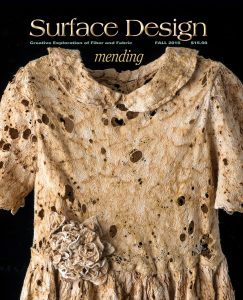
Here’s a little preview of what you’ll discover…
1) “Breaking the Silence” features at Julie Sirek’s moving and emotional work. By openly talking about domestic violence, Sirek strives to break the silence surrounding this issue to make a difference in the world.

Julie Sirek Toe Tag 2016, Vintage tablecloth, screen print, silk thread, screenprinting, hand embroidery, 5.75″ x 2.875″. Photo: Rik Sferra.
2) Why do we love making stuff? “The Healing Power of Textile Arts” by Leesa Hubbell reveals deep motivators and restorative rewards in textile making.
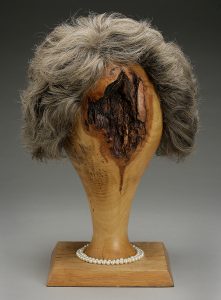
Christine Marie Davis Yvette: Self Portrait with Pearls 2006, wood lamp base, wig, pearl necklace, assemblage of found materials, 15″x15”x24″. Photo: Steve Sonheim.
3) “Men/Mend/Amend: Mark Newport” by Jovencio de la Paz explores the vast range of Newport’s work. From earlier pieces questioning the fraught state of masculinity in America using superheroes, to more recent work exploring the stitch as an agent of material and physical healing as it relates to fatherhood.
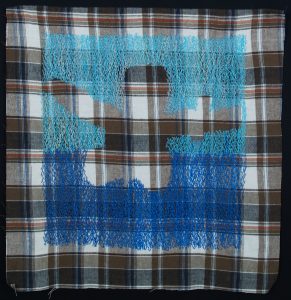
Mark Newport Nevermind 2014, hand embroidery on flannel, 18″x20″. Courtesy of Simone DeSousa Gallery, Detroit, MI.
4) “Mending the Fashion Industry: Scandinavian Style” by Jessica Hemmings spotlights projects which reject current unsustainable models of textile and fashion production like Franz Petter Schmidt’s Weaving Fabrics for Suits and the collaboration between Toril Johannessen and HAIK Fashion Collective- Unlearning Optical Illusions (SS17 Collection).
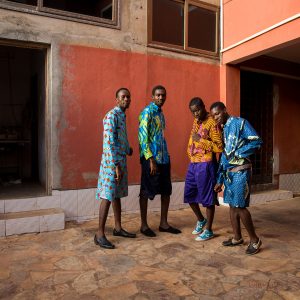
Toril Johannessen collaboration with HAIK Fashion Collective Unlearning Optical Illusions (SS17 Collection) 2016, textile designs by Toril Johannessen, clothing designs by HAiK, 2016. Photo shoot with textile factory workers in Ghana, West Africa. Photos: Nii Odzenma.
5) “The Art of Repair: Skills Sharing to Foster Community and Social Change” by Lisa Vinebaum explores the work of 5 artists utilizing craft and fiber skills to help repair our broken social bonds—some more temporary, while others, more durational.
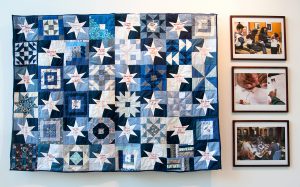
Rachel Wallis Gone But Not Forgotten 2014–ongoing, donated fabric, embroidery thread, quilting thread, batting, embroidery, appliqué, machine and hand quilting, currently 60″ x 40′ with an additional 80″ panel to be added. Photo: Marcia Connolly.
6) Repair is an act of patience and care. “Patched” by Otto von Busch inquires into our constant interest to all things new and how repair fits into our consumer lives.
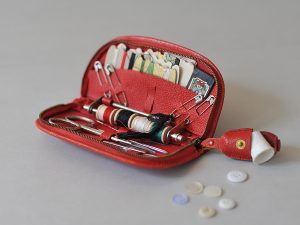
Vintage repair kits from the collection of Aino Allerheim (1911–2007), grandmother of author and designer Otto von Busch. Photos: Otto von Busch.
7) “Making it OK” by Ian Wilson looks at the five artists working with mending (both practically and conceptually) in Liz Cooper’s exhibition What Do I Need to Do to Make It OK?
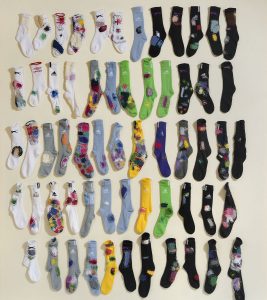
Celia Pym First One’s the Best 2014, 60 sports socks cut up and heavily hand-darned, dimensions variable. Created during the artist’s Parallel Practices 2014 residency in the Dissecting Lab at King’s College, London.
8) In our *new* Made Aware department “Mending Gold: Longitude and Latitude” by Brooks Harris Stevens features a series of site-specific works that address the life of worn cloth by expanding into worn paths in the landscape and built environment, as well as the economic and political realm.
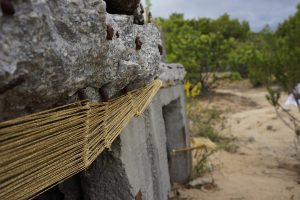
Brooks Harris Stevens Mending Gold: Bunker, Mount Dajti, Albania (detail) 2016 An abandoned deteriorating military bunker in Dajti, Albania, after mending by the artist with gold thread.
In this tumultuous time that we are facing right now, it is critical to be empathetic and kind to those around us. This issue of Surface Design Journal reflects the caring trend that many artists are working towards. Please be kind and loving towards those around you, for everyone is deserving of love and respect. When faced with untenable loss—of life, food, clothing, shelter, health, wealth, power, love, relationships—we muster the courage to rally and rectify.
To buy a copy of “Mending”, go to Surface Design Association’s Marketplace!

Related Blog Articles
African Textiles
Friday Fibers Roundup: Craft & Color
African Textiles
Friday Fibers Roundup: Artistic Approaches
No Thumbnail Available
African Textiles
Friday Fibers Roundup